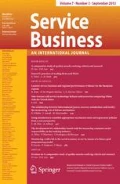Abstract
This paper will present the analysis of data over 3 years (1998, 1999, and 2000) on the satisfaction of flex workers in the context of a flex company’s service excellence programme, as an example of the use of measurements in relation to the change process. The important issues related to the specific data of the flex workers’ satisfaction surveys are: (a) the relationships between perceived satisfaction of flex workers and possible behavioural consequences, like making complaints and making use of other flex companies; (b) the stability of factor constructs over time that identify the major dimensions of satisfaction of flex workers; and (c) the satisfaction dynamics over time.





Similar content being viewed by others
References
Arthur JB (1994) Effects of human resource systems on manufacturing performance and turnover. Acad Manage J 3:670–687
Boselie P, Hesselink M, Paauwe J, van der Wiele A. (2001) Employee perception on commitment oriented work systems: effects on trust and perceived job security. ERIM Report Series Research in Management, ERS-2001–02-ORG, January
Capodagli B, Jackson L (1998) The Disney way. McGraw-Hill, New York
Disney Institute (2001) Be our guest; perfecting the art of customer service. Disney Enterprise Inc, New York
Grönroos C (1984) A service quality model and its marketing implications. Eur J Mark 18(4):36–44
Guest DE (1997) Human resource management and performance: A review and research agenda. Int J Hum Resour Manage 8:263–276
Heskett JL, Sasser WE, Schlesinger LA (1992) The service profit chain. The Free Press, New York
Huselid MA (1995) The impact of human resource management practices on turnover, productivity, and corporate financial performance. Acad Manage J 3:635–672
Levy A, Merry U (1986) Organisational transformation; approaches, strategies, and theories. Praeger, New York
Maister DH (2001) Practice what you preach. The Free Press, New York
Pine BJ II, Gilmore JH (1999) The experience economy. Harvard Business School Press, Boston
Prabhu VB, Robson A (2000) Achieving service excellence - measuring the impact of leadership and senior manager commitment. Manag Serv Qual 10:307–317
van der Wiele A, Boselie PB, Hesselink M (2002) Empirical evidence for the relationship between customer satisfaction and business performance. Managing Serv Qual 12(3):184–193
Youndt MA, Snell SA, Dean JW Jr, Lepak DP (1996) Human resource management, manufacturing strategy, and firm performance. Acad Manage J 39:836–866
Zeithaml VA (2000) Service quality, profitability, and the economic worth of customers: What we know and what we need to learn. J Acad Mark Sci 28:67–85
Author information
Authors and Affiliations
Corresponding author
Rights and permissions
About this article
Cite this article
van der Wiele, T. Longitudinal measurement in organisational transformation: a case of a Dutch Flex Company. Service Business 1, 25–40 (2007). https://doi.org/10.1007/s11628-006-0003-x
Received:
Accepted:
Published:
Issue Date:
DOI: https://doi.org/10.1007/s11628-006-0003-x




